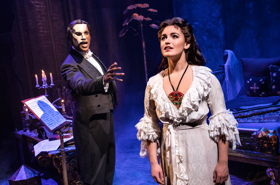Review: THE PHANTOM OF THE OPERA is Here (and he's not going anywhere!)

Those who have seen his face draw back in fear, but for the past 30 years, audiences have been captivated by the man and mystery that is the Phantom of the Opera. To love the man behind the mask, Christine Daaé learns to accept the creature - deformed by nature, gifted as her Angel of Music - for who he is as a person and what he has to offer her. As a musical production, The Phantom of the Opera is a love story that combines raw vocals and acting talent with magnificent set pieces and special effects.
Depending on when you last saw a production of The Phantom of the Opera, you may be in for a fresh, new, reworked surprise. The chandelier, a focal point for the opening auction, is revealed hanging above the audience. It has received a much-needed upgrade, is grander and shinier than ever, and is the first sign that this production is not the same one you saw on Broadway during a high school field trip last decade. When Cameron Mackintosh reworked this classic a few years ago, nearly everything that wasn't written in the libretto was changed, for the better.
The core of the production, though, Andrew Lloyd Weber's The Phantom of the Opera script is of the most popular adaptations of the 1909 French novel of the same name. Taking refuge from the public, the Phantom (Quentin Oliver Lee) makes the Paris Opera House his home. He lives underneath the theater and take a special interest in a dancing soprano, Christine Daaé (Eva Tavares). He privately tutors Christine under the guise of her Angel of Music.
With Carlotta (Trista Moldovan) bumped as the leading soprano in an upcoming production at the Opera House, Christine shines and catches the eye of an old friend and benefactor of the opera, Raoul (Jordan Craig). The Phantom personally congratulates Christine on her performance by revealing his masked self to her and by taking her to his lair; he does this as Raoul was trying to congratulate her - a move that sets up the beginning of the fated love triangle. Moving in the shadows, the Phantom will stop at nothing, even murder, to make Christine fall in love with him over the course of the show.
The descent into the Phantom's lair is another set design that is drastically changed from the original production and tour. Without giving too many spoilers away, the massive set piece has hidden interlocking parts that, when revealed, add to the magic and mystery of the Phantom. Similarly, the Opera House looks more astonishing than ever. Onstage, gilded boxes swivel in place, flanking the action on the center stage. These massive boxes run the length of the curtains and connect the top of the proscenium arch that flops forward. This re-envisioned production certainly takes advantage of twenty-first century technologies while adding great attention to detail.
No matter how many technological advancements are made, musical and stage talent cannot be bought. With the iconic score and large orchestra of this production, the cast is supported immensely without even singing a note; but the ensemble and principal actors rise to the occasion with classics such as "Think of Me" and "Masquerade." Love, passion, and fury are evident in the songs of Raoul and the Phantom, yet it is Christine, whose journey from timid chorus girl to flourishing leading soprano, who wows us all.
The legacy of The Phantom of the Opera is one of tradition and versatility; its tenure is a testament to the timeless story's ability to transcend generations, and its adaptability is proof that the show will succeed another 30+ years. As the Phantom tells Christine, so, too, he tells the audience: "You alone can make my song take flight, Help me make the music of the night."
To see or not to see score: 7/9; Recommended Show
Photo Details: "Music of the Night" (From L) Quentin Oliver Lee as 'The Phantom' and Eva Tavares as 'Christine Daaé'. Photo: Matthew Murphy.
Reader Reviews

Videos


